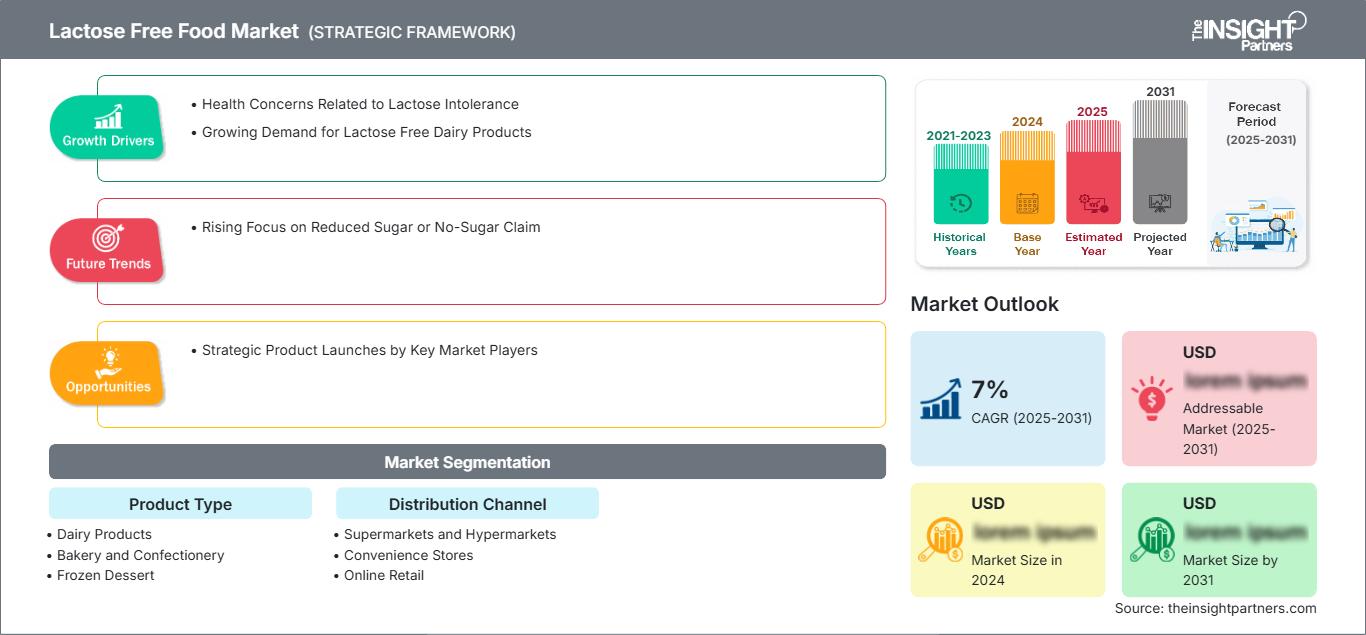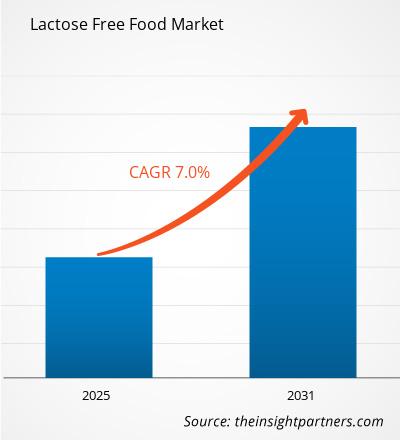Le marché des aliments sans lactose devrait enregistrer un TCAC de 7 % entre 2023 et 2031. Le marché des aliments sans lactose est en croissance en raison de l'intolérance croissante au lactose chez les consommateurs.
Analyse du marché des aliments sans lactose
- L'accent croissant mis sur la santé et le bien-être a conduit à la préférence pour un régime sans lactose pour répondre à des problèmes de santé spécifiques.
- La sensibilisation aux problèmes de santé tels que l'intolérance au lactose est un facteur important qui stimule le marché des aliments sans lactose. Les personnes intolérantes au lactose ressentent des symptômes digestifs lorsqu'elles consomment des produits contenant du lactose, ce qui les incite à privilégier les alternatives sans lactose.
- La demande d'alternatives sans lactose a encouragé les principaux acteurs du marché à développer et à lancer des aliments sans lactose, tels que des plats cuisinés, des produits laitiers, des produits de boulangerie et de confiserie, entre autres.
Aperçu du marché des aliments sans lactose
- Les aliments sans lactose sont fabriqués par des fabricants pour répondre aux besoins des consommateurs intolérants au lactose et soucieux de leur santé, ou qui ont besoin d'aliments sans lactose en fonction de leurs besoins nutritionnels.
- L'intolérance au lactose est une incapacité à décomposer le sucre contenu dans le lait ou les produits laitiers. La sensibilisation croissante des consommateurs à ce sujet a encouragé les personnes concernées à limiter leur consommation de lactose en utilisant des alternatives sans lactose pour gérer leurs symptômes.
- Le marché des aliments sans lactose est en croissance constante en raison de l'évolution des habitudes alimentaires, du comportement des consommateurs et des préoccupations en matière de santé.
Personnalisez ce rapport en fonction de vos besoins
Vous bénéficierez d’une personnalisation sur n’importe quel rapport - gratuitement - y compris des parties de ce rapport, ou une analyse au niveau du pays, un pack de données Excel, ainsi que de profiter d’offres exceptionnelles et de réductions pour les start-ups et les universités
Marché d'aliments sans lactose: Perspectives stratégiques

-
Obtenez les principales tendances clés du marché de ce rapport.Cet échantillon GRATUIT comprendra une analyse de données, allant des tendances du marché aux estimations et prévisions.
Moteurs et opportunités du marché des aliments sans lactose
La demande croissante de produits laitiers sans lactose favorise le marché
La sensibilisation accrue aux problèmes de santé liés à la consommation de produits laitiers a considérablement contribué à la demande d'aliments sans lactose. La sensibilisation croissante des professionnels et d'autres consommateurs à la nutrition quotidienne a développé une préférence pour certains produits alimentaires et boissons qui reflètent leur mode de vie plus sain. Les produits alimentaires sans lactose répondent à la demande du marché des consommateurs qui souhaitent réduire leur consommation de lactose pour plusieurs raisons, telles que l'intolérance au lactose ou un régime pauvre en produits laitiers. Ces dernières années, le développement de nouveaux procédés et technologies dans l'industrie laitière a contribué à améliorer la fonctionnalité et les profils sensoriels des produits laitiers. La disponibilité des aliments sans lactose sur le marché s'est donc considérablement accrue.
Lancements stratégiques de produits par les principaux acteurs du marché
Grâce à des lancements stratégiques de produits sans lactose, les acteurs du marché répondent aux demandes alimentaires des consommateurs intolérants au lactose. L'introduction d'alternatives innovantes sans lactose sur le marché par les entreprises a permis d'élargir la gamme de produits alimentaires sans lactose. Ces produits alimentaires ont un goût et une texture similaires à ceux des produits laitiers conventionnels. Français Les acteurs du marché s'efforcent en permanence d'introduire de nouveaux produits sans lactose, d'élargir leurs gammes de produits et de répondre aux demandes évolutives des consommateurs intolérants au lactose.
Analyse de la segmentation du marché des aliments sans lactose
Les principaux segments qui ont contribué à l'élaboration de l'analyse du marché des aliments sans lactose sont le type de produit et le canal de distribution.
- En fonction du type de produit, le marché des aliments sans lactose est divisé en produits laitiers, boulangerie et confiserie, desserts glacés, nutrition sportive et autres.
- En fonction du canal de distribution, le marché est divisé en supermarchés et hypermarchés, magasins de proximité, vente au détail en ligne et autres.
Analyse des parts de marché des aliments sans lactose par zone géographique
- Le rapport sur le marché des aliments sans lactose comprend une analyse détaillée de cinq grandes régions géographiques, qui comprend la taille actuelle et historique du marché et les prévisions pour 2021 à 2031, couvrant l'Amérique du Nord, l'Europe, l'Asie-Pacifique, le Moyen-Orient et l'Afrique. Afrique, Amérique du Sud et Amérique centrale.
- Chaque région est subdivisée en pays respectifs. Ce rapport fournit des analyses et des prévisions pour plus de 18 pays, couvrant la dynamique du marché des aliments sans lactose, notamment les moteurs, les tendances et les opportunités qui impactent les marchés à l'échelle régionale.
- Le rapport couvre également l'analyse des cinq forces de Porter, qui comprend l'étude des principaux facteurs influençant le marché des aliments sans lactose dans ces régions.
Marché d'aliments sans lactose
Les tendances et facteurs régionaux influençant le marché des aliments sans lactose tout au long de la période de prévision ont été analysés en détail par les analystes de The Insight Partners. Cette section aborde également les segments et la géographie du marché des aliments sans lactose en Amérique du Nord, en Europe, en Asie-Pacifique, au Moyen-Orient et en Afrique, ainsi qu'en Amérique du Sud et en Amérique centrale.
Portée du rapport sur le marché des aliments sans lactose| Attribut de rapport | Détails |
|---|---|
| Taille du marché en 2024 | US$ XX million |
| Taille du marché par 2031 | US$ XX Million |
| TCAC mondial (2025 - 2031) | 7% |
| Données historiques | 2021-2023 |
| Période de prévision | 2025-2031 |
| Segments couverts |
By Type de produit
|
| Régions et pays couverts |
Amérique du Nord
|
| Leaders du marché et profils d'entreprises clés |
|
Densité des acteurs du marché des aliments sans lactose : comprendre son impact sur la dynamique commerciale
Le marché des aliments sans lactose connaît une croissance rapide, porté par une demande croissante des consommateurs, due à l'évolution des préférences des consommateurs, aux avancées technologiques et à une meilleure connaissance des avantages du produit. Face à cette demande croissante, les entreprises élargissent leur offre, innovent pour répondre aux besoins des consommateurs et capitalisent sur les nouvelles tendances, ce qui alimente la croissance du marché.
- Obtenez le Marché d'aliments sans lactose Aperçu des principaux acteurs clés
Actualités et développements récents du marché des aliments sans lactose
Le marché des aliments sans lactose est évalué en collectant des données qualitatives et quantitatives après des recherches primaires et secondaires, qui comprennent d'importantes publications d'entreprise, des données d'associations et des bases de données. Quelques-uns des développements sur le marché des aliments sans lactose sont énumérés ci-dessous :
- Valio lance un nouveau segment de produits pour permettre des produits protéinés au goût meilleur. (Source : Valio Ltd/Communiqué de presse/novembre 2023)
- Prairie Farms lance de nouveaux produits laitiers sans lactose. (Source : Prairie Farms Dairy Inc/Communiqué de presse/avril 2024)
- Hiland Dairy proposera du lait frais sans lactose produit dans son usine de Kansas City. (Source : Hiland Dairy/Communiqué de presse/mars 2024)
Couverture et livrables du rapport sur le marché des aliments sans lactose
La « Taille et prévisions du marché des aliments sans lactose (2021 - 2031) » Fournit une analyse détaillée du marché couvrant les domaines suivants :
- Taille et prévisions du marché des aliments sans lactose aux niveaux mondial, régional et national pour tous les segments de marché clés couverts par le champ d’application
- Tendances du marché des aliments sans lactose ainsi que dynamiques du marché telles que les moteurs, les contraintes et les opportunités clés
- Analyse détaillée des cinq forces de Porter et SWOT
- Analyse du marché des aliments sans lactose couvrant les principales tendances du marché, le cadre mondial et régional, les principaux acteurs, les réglementations et les développements récents du marché
- Analyse du paysage industriel et de la concurrence couvrant la concentration du marché, l’analyse de la carte thermique, les principaux acteurs et les développements récents pour le marché des aliments sans lactose
- Profils d’entreprise détaillés
- Analyse historique (2 ans), année de base, prévision (7 ans) avec TCAC
- Analyse PEST et SWOT
- Taille du marché Valeur / Volume - Mondial, Régional, Pays
- Industrie et paysage concurrentiel
- Ensemble de données Excel
Rapports récents
Rapports connexes
Témoignages
Raison d'acheter
- Prise de décision éclairée
- Compréhension de la dynamique du marché
- Analyse concurrentielle
- Connaissances clients
- Prévisions de marché
- Atténuation des risques
- Planification stratégique
- Justification des investissements
- Identification des marchés émergents
- Amélioration des stratégies marketing
- Amélioration de l'efficacité opérationnelle
- Alignement sur les tendances réglementaires






















 Obtenez un échantillon gratuit pour - Marché d'aliments sans lactose
Obtenez un échantillon gratuit pour - Marché d'aliments sans lactose